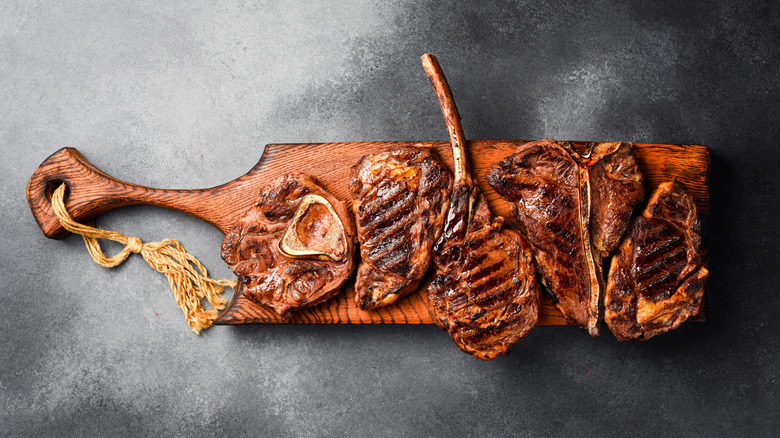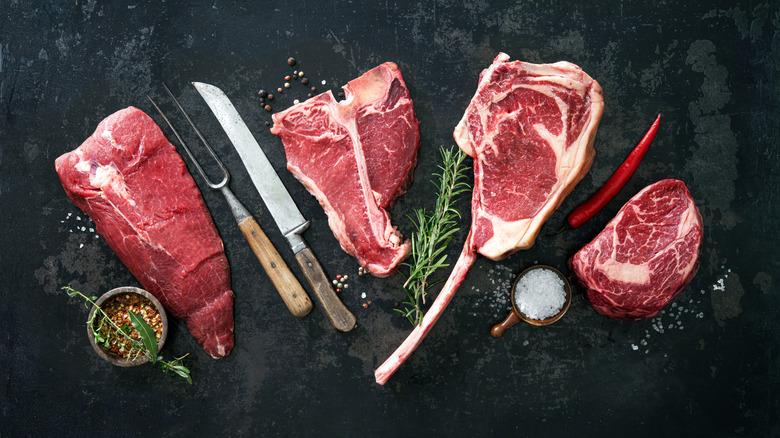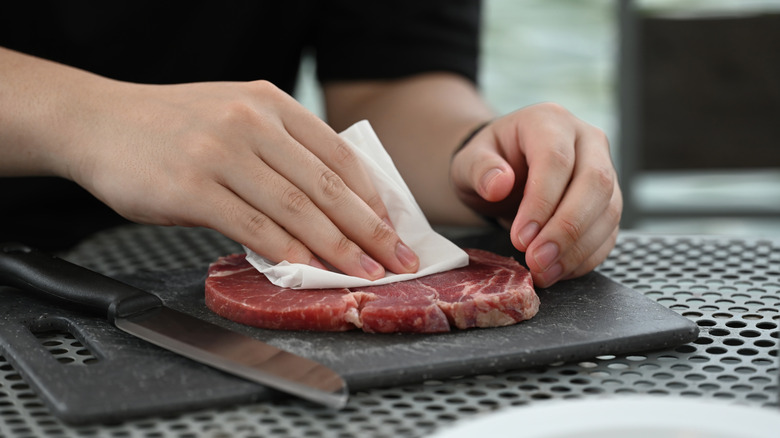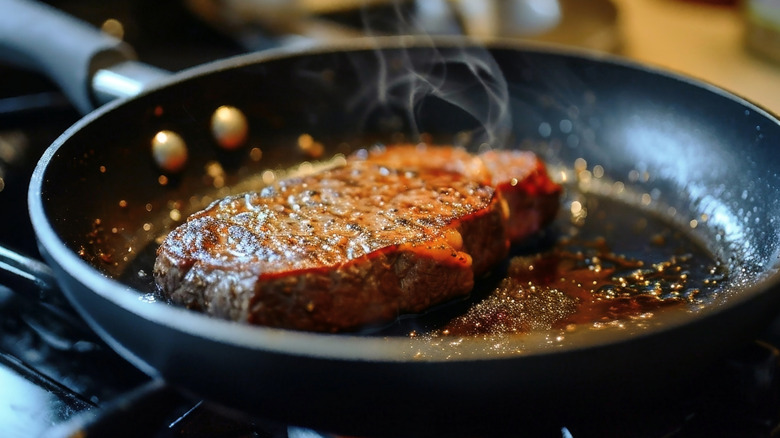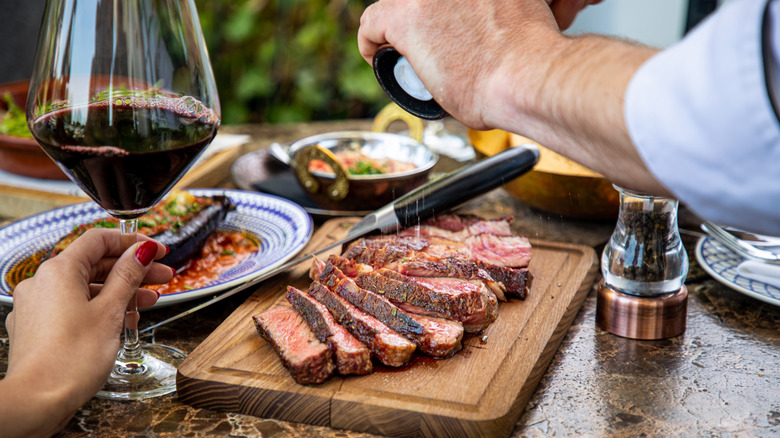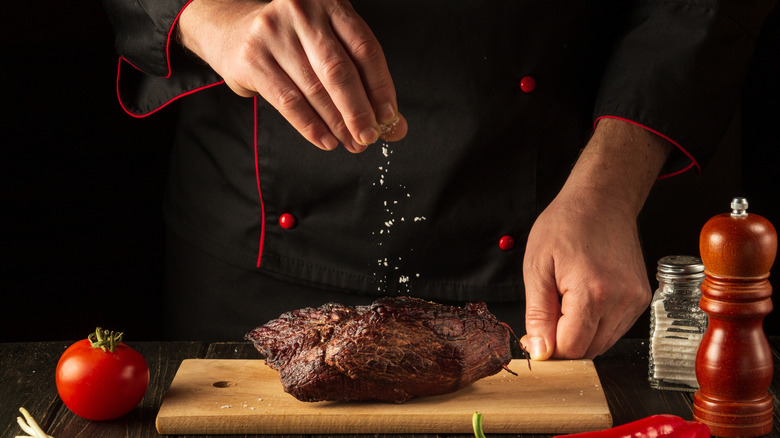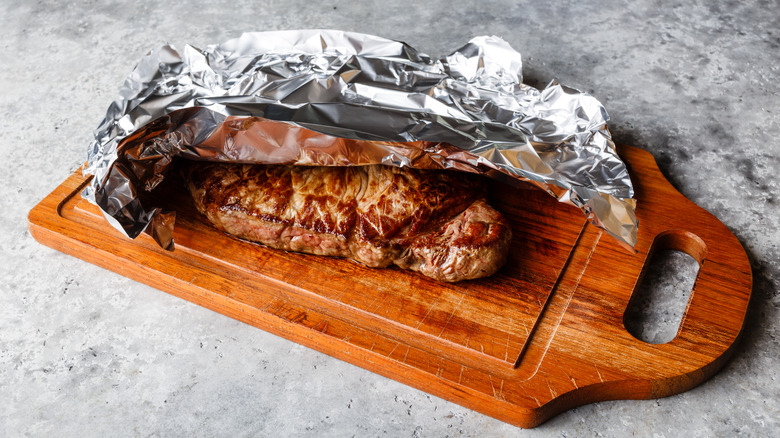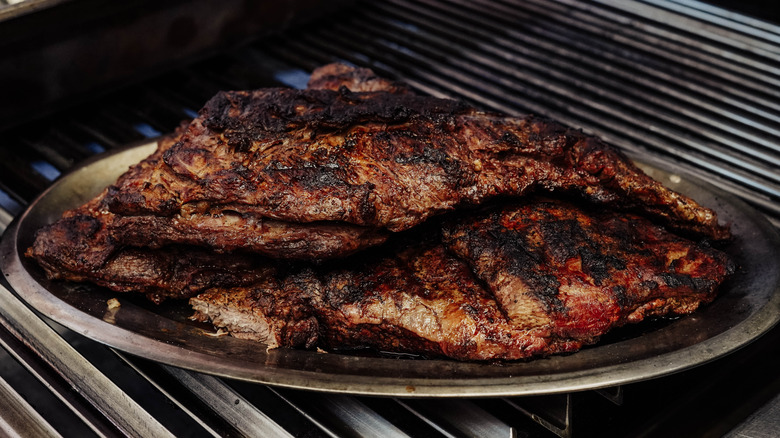7 Tips You Need To Serve Steak And Impress Your Guests
A well-made steak is a quick way to earn the admiration of your guests, but why settle for something ordinary? Professional chefs swear by hundreds of tips and tricks to improve steaks, but parsing through them all to cultivate the perfect recipe is a hassle — especially if you're cooking for others.
Ultimately, they all boil down to three basic principles: choosing the right cut, preparing it according to its specific needs, and serving it in a way that enhances both its flavor and presentation. To uncover the best ways to accomplish these three goals, we spoke with two experts: Geoff Baumberger, regional chef for Butcher and Rose of Cameron Mitchell Restaurants, and Joanne Gallagher, recipe creator and co-founder of Inspired Taste. Whether you're rescuing an overcooked steak or debating the need to let it rest, Baumberger and Gallagher have more than enough combined experience to answer your most vexing questions.
Pick the right cut of meat
"Sirloin is a great and often more affordable option," Joanne Gallagher says. "It's leaner than other cuts, so it cooks quickly and delivers a clean, beef-forward flavor — but that also means it can dry out if overcooked." Lean cuts are fantastic for high-temperature broiling and hot grilling, especially if your guests prefer their steaks rare. If they appreciate the simplicity of high-quality beef, just a sprinkle of salt and pepper brings a sirloin's flavor to life without overwhelming it.
"On the other hand, flank, skirt, and hanger steak are incredibly flavorful and have a looser grain that soaks up marinades beautifully, making them perfect for bold, high-impact dishes," Gallagher tells us. If you're looking for large cuts that hold immense flavor, look no further. These cuts shine in dishes like fajitas and rice bowls, but are just as satisfying as a standalone entree.
"Tri-tip is another excellent choice because it has great marbling, which helps keep it juicy and tender while still being easy to cook for a group," says Gallagher. If your guests love ribeyes and other marbled meats, tri-tip is a great way to avoid cooking multiple individual steaks. Whether you're using a pan or a grill, it's easy to develop a beautiful sear without overcooking the center.
Pat dry any cut of meat you cook
Ever had a steak that was perfectly cooked on the inside but had a grayish, flavorless exterior? Chances are, the chef should have reached for some paper towels before cooking the meat.
"One of the biggest mistakes people make when searing steak is not patting it dry first," says Joanne Gallagher. "Any extra moisture on the surface keeps it from getting that deep, golden crust."
The Maillard reaction — the chemical process responsible for flavorful meat crusts — requires high temperatures to occur properly. Excess moisture, particularly on the surface of the meat, slows it down, leaving you with the terrible choice of either overcooking your steak or ending up with no crust at all.
If you're worried about your seasonings not adhering to a dry surface, give your steak a thin coating of oil rather than relying on its exterior moisture. Fat provides just enough thermal insulation against burning without inhibiting the Maillard reaction.
Preheat the cooking surface for the perfect sear
While searing meat doesn't actually lock in juices, it's even more crucial for developing a steak's flavor than seasoning. To get it right, use higher heat for steaks you plan to cook rare, and lower heat for medium to well-done. If you're cooking on a grill, once the sear has developed, moving steaks that need to cook longer to the edges is a smart move.
"To get a great sear, you want to use high heat to begin with and allow the pan or grill to get hot enough before placing whatever you are searing in or on it," Geoff Baumberger says. A cooking surface's temperature drops dramatically when it comes into contact with meat, especially on the stove, so don't worry too much about maintaining intense heat throughout the entire cook.
"Secondly, give whatever is being seared enough time before trying to flip or turn," Baumberger tells us. "Home cooks should be patient and wait before turning or flipping so it has a chance to develop a crust with great color and texture." It may be tempting to move your steak around to prevent burning, but that can interfere with proper crust formation. The perfect sear is all about timing and heat control — and practice makes perfect.
Serve your steaks family style
"In my opinion, one of the best ways to prepare steak for a group is to cook and serve family style, cooking any steaks with staggered timing and allowing meat to rest before slicing so that everyone can see what they are getting," says Geoff Baumberger. Whether you're using a grill or a stovetop, even trained chefs like Baumberger find it difficult to get every steak perfect. This method ensures that even if one or two cuts aren't quite right, no guest is left with an over- or undercooked steak.
"Most likely the cuts of steak will cook differently based on size and time, as well as position on the grill," Baumberger says. "There will be a variety of doneness to select from and slicing it allows for everyone to see what they are getting." By slicing all the steaks beforehand, arranging them on a board according to their level of doneness, and letting guests serve themselves, you save time and avoid headaches — while guaranteeing that everyone walks away happy.
Plus, slicing all those steaks on one surface leaves behind plenty of flavorful juices for your guests to soak up to their hearts' content. No family-style meal is complete without a basket of bread in the middle, so set out some yeasty rolls, fluffy bread, or even biscuits and let your dinner guests help with the cleanup.
Finish your steaks with extra flavor
So, you've picked the perfect cut, cooked it to perfection, and still want more flavor? Sounds like you're in the same boat as Geoff Baumberger, who has some suggestions for adding a finishing touch that will elevate your dish.
"At Butcher & Rose, our newest concept, we finish all our steaks with a small amount of Wagyu Beef Tallow, which provides great natural flavor and a sprinkle of large flake finishing salt that provides a little crunch," Baumberger says. "Simply done, we let the quality of the meat speak for itself." While the flavors from seasonings, oils, and cooking methods form the foundation of your steak's taste, a finishing ingredient introduces something entirely new and exciting to your dish.
Paired with the roasted taste of a well-developed crust, a finishing touch can expand your steak's flavor profile in unexpected ways. In addition to beef tallow, Baumberger recommends a drizzle of high-quality olive oil for a hint of earthiness or even a splash of aged balsamic vinegar to brighten up the hearty dish. Much like his suggestion of large-flake salt, any additional dry seasonings should be coarsely ground to enhance texture.
Let your steaks rest
Once your steaks have reached optimal flavor and your guests are ready to eat, there's one last step you can't afford to skip: resting. Many chefs believe resting is the most crucial step for perfect steak, and it applies anytime you roast, grill, or sear meat — not just at dinner parties.
"I think most home cooks overlook the resting part of the cooking process, and this hurts the steak itself as well as the presentation," Geoff Baumberger says. "By cooking a great quality steak to the desired temperature and allowing it to rest, the steak will not only eat better from the guest perspective, but it will also be much cleaner looking on the plate by not 'bleeding out' or sitting in its own juices." Treat the rest period as your final chance to optimize flavor. Whether you're whipping up a sauce or sprinkling on a finishing ingredient, resting gives you a brief moment to breathe before enjoying your meal.
If some of your steaks are still cooking, you can tent the ready ones with foil to help them stay warm. Microwaves offer great insulation and are one of the best places to let meat rest while you finish up final cooking tasks. After removing the steaks from their resting platter, feel free to drizzle their excess juices over the meat before serving — or incorporate them into your sauces.
Don't throw out an overcooked steak
If worst comes to worst and you've overcooked a few steaks, there's no need to panic. While they may not turn out exactly as you intended, Joanne Gallagher has a couple of tips to ensure they stay delicious.
"For an overcooked steak, slicing it and serving it with a sauce — like a pan reduction, chimichurri, or even a simple garlic butter — can bring back moisture and make it more enjoyable," Gallagher says. "If you need a total rescue, you can repurpose the steak in tacos, grain bowls, or sandwiches, where other textures and flavors help balance it out."
If you've cooked multiple steaks, put their excess juices to work in a pan reduction. A thick slice of onion, a garlic clove, and a dash of red wine or beef stock are all you need to create something mouthwatering.
If, instead, you choose to repurpose the steak in a dish where texture and doneness aren't as critical, consider recipes that call for a sauce or multiple complementary ingredients. An overcooked steak might be too pricey to simply throw away, but it can easily become the star of future lunches.

